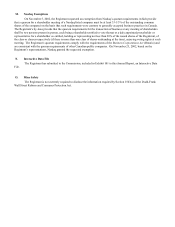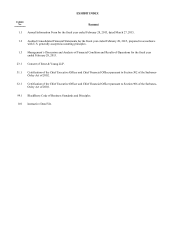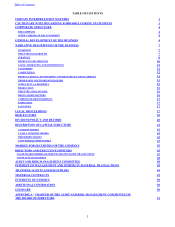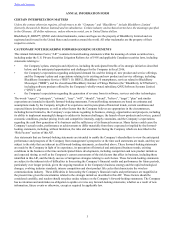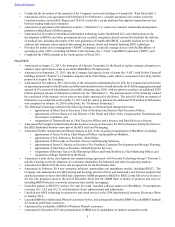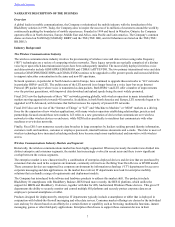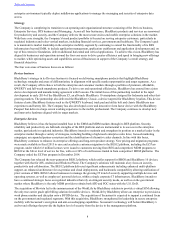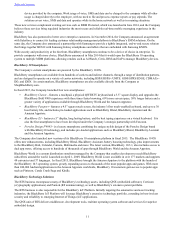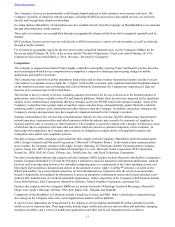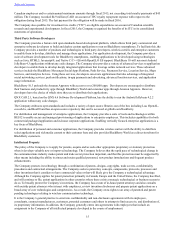Blackberry 2015 Annual Report Download - page 16
Download and view the complete annual report
Please find page 16 of the 2015 Blackberry annual report below. You can navigate through the pages in the report by either clicking on the pages listed below, or by using the keyword search tool below to find specific information within the annual report.
Table of Contents
7
NARRATIVE DESCRIPTION OF THE BUSINESS
Overview
A global leader in mobile communications, the Company revolutionized the mobile industry with the introduction of the
BlackBerry solution in 1999. Today, the Company aims to inspire the success of its millions of customers around the world by
continuously pushing the boundaries of mobile experiences. Founded in 1984 and based in Waterloo, Ontario, the Company
operates offices in North America, Europe, Middle East and Africa, Asia Pacific and Latin America. The Company’s common
shares are listed on NASDAQ (NASDAQ: BBRY) and the TSX (TSX: BB), and its Debentures are listed on the TSX (TSX:
BB.DB.U).
Industry Background
The Wireless Communications Industry
The wireless communications industry involves the provisioning of wireless voice and data services using radio frequency
(“RF”) technologies on a variety of competing wireless networks. These legacy networks are typically comprised of a distinct
voice layer upon which data transmission layers have been subsequently installed. The most widely deployed wireless voice
and data networks include GSM/GPRS/EDGE/HSPA and CDMA/1xRTT/EVDO. The two primary international voice and data
networks GSM/GPRS/EDGE/HSPA and CDMA/EVDO continue to be upgraded to offer greater speeds and increased abilities
to support subscriber concentration in the same and new RF spectrums.
Network operators, in particular in North America and in Europe, have continued to upgrade those networks to “4G” networks
in particular HSPA+ and LTE. The architecture of the LTE network is no longer based on a voice layer but on an Internet
Protocol (IP) packet layer where voice is transmitted as data packets. Both HSPA+ and LTE offer a number of improvements
over the previous generations, with improved data download and upload speeds being the most widely promoted.
Fiscal 2015 saw the deployments of these “4G” networks growing globally, with wireless operators in many international
markets moving aggressively towards 4G networks. In addition, in both North America and Europe, LTE networks began to be
upgraded to LTE-Advanced, with features that further increase the capacity of present LTE networks.
Fiscal 2015 also saw the rise of the “Internet of Things” or “IoT” and “Machine to Machine” or “M2M” markets as a driving
force for the expansion of new wireless applications, with many wireless operators establishing relationships, practices and
partnerships focused around those new markets. IoT refers to a new generation of devices that communicate over wireless
networks to other wireless devices or end-users, while M2M refers specifically to machines that communicate with other
machines over wireless networks.
Finally, Fiscal 2015 saw numerous security data breaches in large enterprises by hackers seeking personal identity information,
customer credit card numbers, customer or employee passwords, internal business documents and e-mails. The risks to users of
wireless technology have increased as hacking methods have become much more sophisticated and innovative with wireless
access.
Wireless Communications Industry Markets and Segments
Historically, the wireless communications market has been highly segmented. Whereas previously the market was divided into
distinct enterprise and consumer segments, the market has increasingly evolved in recent years and there is now significant
overlap between the various segments.
The enterprise market is now characterized by a combination of enterprise-deployed devices and devices that are purchased by
consumers but also used in the corporate environment, commonly referred to as the Bring Your Own Device or BYOD model.
These consumer devices are supported in a corporate environment by information technology (“IT”) departments for access to
corporate messaging and data applications. As the market has evolved, IT departments now look for enterprise mobility
solutions that can handle a range of requirements and deployment models.
The Company has introduced both software and hardware products to address this market shift. The products include
BlackBerry 10 smartphones with BlackBerry Balance, BES10 and more recently, the BES12 platform, which unifies the
support for BBOS and BlackBerry 10 devices, together with that for iOS, Android and Windows Phone devices. This gives IT
departments the ability to securely monitor and control multiple OS platforms and securely protect corporate data on an
employee’s personal smartphone or tablet.
Products designed for deployment by enterprise IT departments typically include a smartphone or tablet that is deployed in
conjunction with behind-the-firewall messaging and other data servers. Consumer market offerings are chosen by the individual
user and may be chosen based on an affinity for a certain feature or capability such as browsing, multimedia functions, instant
messaging, games or other third-party applications. Enterprises that choose to support these consumer devices in their


